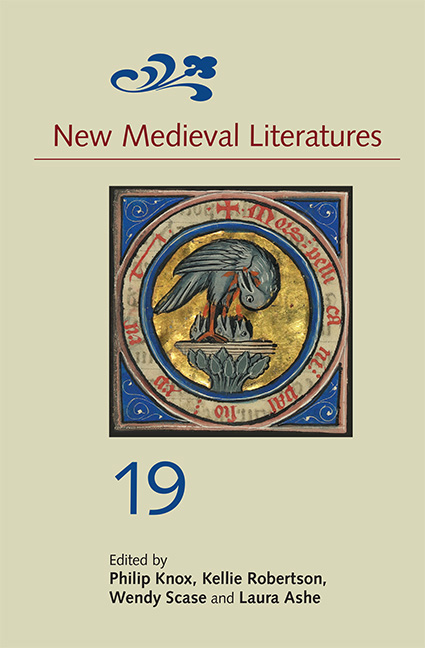Book contents
- Frontmatter
- Contents
- 1 A Scottish or English Saint? The Shifting Sanctity of St Aebbe of Coldingham
- 2 Monastic History-Writing and Memory in Britain and Ireland: A Methodological Reassessment
- 3 Language, Morality, and Wordplay in Thirteenth-Century Anglo-French: The Poetry of Walter de Bibbesworth
- 4 Open Form and Canonic Matter in Trecento Song
- 5 ‘Uninhabited’: Eco-Colonial Anxieties in Late Medieval Icelandic Saga
- 6 ‘Betwen tuo stoles’: The Western Schism and the English Poetry of John Gower (1378–1417)
- 7 Cognition and Conversion in Alain Chartier's Livre de l'Espérance
4 - Open Form and Canonic Matter in Trecento Song
Published online by Cambridge University Press: 31 August 2019
- Frontmatter
- Contents
- 1 A Scottish or English Saint? The Shifting Sanctity of St Aebbe of Coldingham
- 2 Monastic History-Writing and Memory in Britain and Ireland: A Methodological Reassessment
- 3 Language, Morality, and Wordplay in Thirteenth-Century Anglo-French: The Poetry of Walter de Bibbesworth
- 4 Open Form and Canonic Matter in Trecento Song
- 5 ‘Uninhabited’: Eco-Colonial Anxieties in Late Medieval Icelandic Saga
- 6 ‘Betwen tuo stoles’: The Western Schism and the English Poetry of John Gower (1378–1417)
- 7 Cognition and Conversion in Alain Chartier's Livre de l'Espérance
Summary
At what point does an act of imitation become a form of art? Both the infant and the actor depend on the persuasive imitation of the speech worlds they wish to inhabit, though the question of art is apposite in only one case. The infant's aim is to acquire language; the accurate reproduction of the speech-sounds around her promises the currency of signification through which she will join a linguistic community. For the actor, the aim is representation. Unlike the infant, the actor does not wish to enter into reality qua language, but rather to detach, fix, and transpose it – to confer a separate internal rhythm, logic, and structure onto the events enacted. For the one the end of imitation is the sign, and for the other it is the form.
Poetry, of course, frustrates this binary. Through its sonic density and repetitions, it brings language's formal features into focus, producing alongside the signifying text a parallel one, governed not simply by the laws of grammar, but by number and proportion as well. For medieval grammarians, rhetoricians, and philosophers, poetry's formal enhancement of language through measure, consonance, and rhyme brought it squarely into the precincts of music, construed since antiquity as the science of sounding number. It is this patterning of linguistic sound that led the English grammarian, John of Garland, to speak of poetry as ‘a species of art like music’, and Dante Alighieri, a halfcentury or so later, as ‘nothing other than a verbal invention composed according to the rules of rhetoric and music’. In the twentieth century, Theodor Adorno ran the equation in the opposite direction, maintaining ‘music [to be] similar to language in that it is a temporal succession of articulated sounds that are more than just sounds’, but different in that ‘[music] does not form a system of signs’. Music is form, he would have it, but not a form of signification.
This essay explores the formal affinities that theorists of poetry, music, and culture perceived between language and music around the turn of the fourteenth century, and how these perceptions in turn shaped vernacular song practices in trecento Italy.
- Type
- Chapter
- Information
- New Medieval Literatures 19 , pp. 121 - 150Publisher: Boydell & BrewerPrint publication year: 2019



